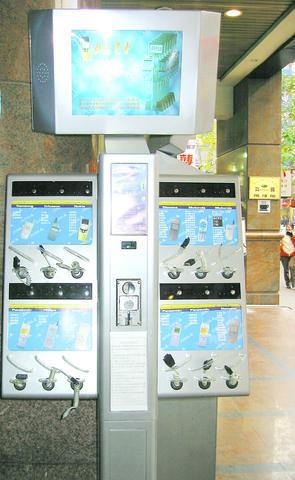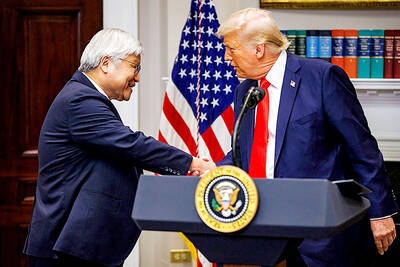Over the last two years, Genevieve Bell, an anthropologist employed by Intel Research, has visited 100 households in 19 cities in seven countries in Asia and the Pacific to study how people use technology.
Twenty gigabytes of digital photos later -- along with 329,600km, 19 field notebooks, two camera batteries, five umbrellas, three hats, two doses of anti-malarial drugs and one pair of her favorite sandals -- she has come back with some provocative questions about technology, culture and design.

PHOTO: NY TIMES
Some of what she learned in the field will be folded into Intel's design process, passed on to industrial designers and engineers and perhaps eventually embodied in a device. But many of Bell's findings also raise deep questions about the meaning of technology in an interconnected world.
Her fieldwork project began four years ago with the insight that Intel might have a misconception about the potential users of its products elsewhere in the world.
"We thought, there's a group of people just like us all over the world who will buy the technology and have it fill the same values in their lives," Bell said. "I was fairly certain that wasn't going to be the case. I'm an anthropologist. Culture matters."
Bell, 37, who received her doctorate in anthropology from Stanford University with a dissertation on American Indian boarding schools, joined Intel in 1998. She is working on a book for MIT Press about her Asian research.
Bell's project sent her to seven countries: India, China, Singapore, Indonesia, Malaysia, South Korea and Australia. She found that in some places, "It's harder for some forms of technology to get over the threshold of the home" -- not simply for economic reasons but for religious ones as well. For example, she said, values of humility and simplicity may make technology less welcome in some Hindu homes in India or some Muslim homes in Malaysia and Indonesia.
"If part of the value of the home is this space of purity that's protected from the pollutedness of the world, a place where you express values like simplicity, humility, modesty, grace," Bell said, "that becomes a barrier to adopting some technologies."
She also pointed out that most US homes have space for leisure activities, and often that space is private. By contrast, Japan's tighter quarters afford little privacy, which may account for the attraction of young people there to text-messaging over mobile phones.
Even the reliability of power may be an American assumption to be overcome: In Malaysia, power surges caused by monsoons can fry computer motherboards.
Such insights challenged Intel's vision of a world of "smart homes" and a chip-driven lifestyle, Bell said, which assumes that users are secular. In those visions, there's no point at which residents stop to pray, visit a church, or have a moment of internal reflection.
All this prompted her to ask David Tanenhaus, Intel's vice president of research: "What if our vision of ubiquitous computing is so secular, so profoundly embedded in a set of Western discourses, that we've created a vision of the world that shuts out a percentage of people in a way we can't really even begin to articulate?"
Intel is not alone in wanting to know more about values and habits in emerging markets.
"Over the last 18 months we've seen more interest in doing international and intercultural research in design for products," said Mike Kuniavsky, a principal with Adaptive Path, a San Francisco-based consulting firm that works with international clients like Peoplesoft, a major business-software company.
For instance, the South Korean electronics company LG Electronics has introduced a mobile phone with an embedded compass to allow Muslim users to locate the direction of Mecca using Global Positioning System technology.
In the past, marketing teams might have been given the task of making a product cross-culturally palatable. Increasingly, however, culture is taken into account earlier, at the design stage.
For its part, Intel relies on a cycle of design that begins with high-level prognostication about potential markets. Then ethnographers like Bell and market researchers are sent to meet those people. The resulting information is incorporated into portraits of individual users. These portraits, called personas, describe a person's life.
"This personifies something that otherwise looks like an aggregate of people," explained Herman D'Hooge, Intel's innovation strategist, who is in charge of acting on insights like Bell's.
One such "persona" that Bell produced in China describes "Sally Lu," a 25-year-old woman living in Shanghai -- a day in her life, her activities and concerns, her attitudes about technology.
"She thinks that new high-tech products must not be too expensive, and the functions don't need to be too fancy," like cellphones with video screens, the document says. "As long as it fulfills basic functions and is easy to operate, people will like it and buy it.
These personas become tools to help industrial designers and engineers understand how users think about products. The challenge, D'Hooge said, is to keep the element of innovation open for as long as possible in this process. By understanding their users, they hope to produce radically innovative concept devices for little risk.
For Intel, a first iteration of this user-centered design cycle yielded a combination PC-entertainment center for use by people in small living spaces, while the second resulted in a PC-like device intended for Chinese users who could not afford a full-size machine. (This concept device has not yet been released.)
Bell recognizes that translating her ideas into products is difficult.
"These things are interesting as a design brief," she said. "They're really hard as a product challenge."
She said that technology companies like Intel should nevertheless be willing to consider information that challenges the grander visions of technology. This involves challenging some Western cultural assumptions about digital technology.
"I think I would like to imagine that I am doing the thing that all anthropologists do," she said, "asking these harder questions about what is real and true."

CRITICAL MOVE: TSMC’s plan to invest another US$100 billion in US chipmaking would boost Taiwan’s competitive edge in the global market, the premier said The government would ensure that the most advanced chipmaking technology stays in Taiwan while assisting Taiwan Semiconductor Manufacturing Co (TSMC, 台積電) in investing overseas, the Presidential Office said yesterday. The statement follows a joint announcement by the world’s largest contract chipmaker and US President Donald Trump on Monday that TSMC would invest an additional US$100 billion over the next four years to expand its semiconductor manufacturing operations in the US, which would include construction of three new chip fabrication plants, two advanced packaging facilities, and a research and development center. The government knew about the deal in advance and would assist, Presidential

‘DANGEROUS GAME’: Legislative Yuan budget cuts have already become a point of discussion for Democrats and Republicans in Washington, Elbridge Colby said Taiwan’s fall to China “would be a disaster for American interests” and Taipei must raise defense spending to deter Beijing, US President Donald Trump’s pick to lead Pentagon policy, Elbridge Colby, said on Tuesday during his US Senate confirmation hearing. The nominee for US undersecretary of defense for policy told the Armed Services Committee that Washington needs to motivate Taiwan to avoid a conflict with China and that he is “profoundly disturbed” about its perceived reluctance to raise defense spending closer to 10 percent of GDP. Colby, a China hawk who also served in the Pentagon in Trump’s first team,

SEPARATE: The MAC rebutted Beijing’s claim that Taiwan is China’s province, asserting that UN Resolution 2758 neither mentions Taiwan nor grants the PRC authority over it The “status quo” of democratic Taiwan and autocratic China not belonging to each other has long been recognized by the international community, the Mainland Affairs Council (MAC) said yesterday in its rebuttal of Beijing’s claim that Taiwan can only be represented in the UN as “Taiwan, Province of China.” Chinese Minister of Foreign Affairs Wang Yi (王毅) yesterday at a news conference of the third session at the 14th National People’s Congress said that Taiwan can only be referred to as “Taiwan, Province of China” at the UN. Taiwan is an inseparable part of Chinese territory, which is not only history but

INVESTMENT WATCH: The US activity would not affect the firm’s investment in Taiwan, where 11 production lines would likely be completed this year, C.C. Wei said Investments by Taiwan Semiconductor Manufacturing Co (TSMC, 台積電) in the US should not be a cause for concern, but rather seen as the moment that the company and Taiwan stepped into the global spotlight, President William Lai (賴清德) told a news conference at the Presidential Office in Taipei yesterday alongside TSMC chairman and chief executive officer C.C. Wei (魏哲家). Wei and US President Donald Trump in Washington on Monday announced plans to invest US$100 billion in the US to build three advanced foundries, two packaging plants, and a research and development center, after Trump threatened to slap tariffs on chips made